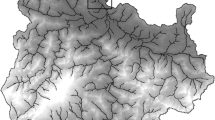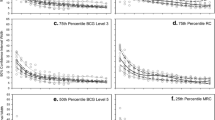Abstract
The Wisconsin Department of Natural Resources (WDNR), with support from the U.S. EPA, conducted an assessment of wadeable streams in the Driftless Area ecoregion in western Wisconsin using a probabilistic sampling design. This ecoregion encompasses 20% of Wisconsin’s land area and contains 8,800 miles of perennial streams. Randomly-selected stream sites (n = 60) equally distributed among stream orders 1–4 were sampled. Watershed land use, riparian and in-stream habitat, water chemistry, macroinvertebrate, and fish assemblage data were collected at each true random site and an associated “modified-random” site on each stream that was accessed via a road crossing nearest to the true random site. Targeted least-disturbed reference sites (n = 22) were also sampled to develop reference conditions for various physical, chemical, and biological measures. Cumulative distribution function plots of various measures collected at the true random sites evaluated with reference condition thresholds, indicate that high proportions of the random sites (and by inference the entire Driftless Area wadeable stream population) show some level of degradation. Study results show no statistically significant differences between the true random and modified-random sample sites for any of the nine physical habitat, 11 water chemistry, seven macroinvertebrate, or eight fish metrics analyzed. In Wisconsin’s Driftless Area, 79% of wadeable stream lengths were accessible via road crossings. While further evaluation of the statistical rigor of using a modified-random sampling design is warranted, sampling randomly-selected stream sites accessed via the nearest road crossing may provide a more economical way to apply probabilistic sampling in stream monitoring programs.
Similar content being viewed by others
References
Barbour, M. T., Gerritsen, J., Snyder, B. D., & Stribling, J. B. (1999). Rapid bioassessment protocols for use in streams and wadeable rivers: Periphyton, benthic macroinvertebrates, and fish, second edition. EPA 841-B-99-002. Washington: U. S. Environmental Protection Agency, Office of Water.
Becker, G. C. (1983). Fishes of Wisconsin. Madison: University of Wisconsin Press.
Cochran, W. G. (1977). Sampling techniques (3rd ed.). New York: Wiley.
Diaz-Ramos, S., Stevens, D. L. Jr., & Olsen, A. R. (1996). EMAP statistical methods manual. EPA/620/R-96/002. U.S. Environmental Protection Agency, Office of Research and Development, National Health Effects and Environmental Research Laboratory, Western Ecology Division, Corvallis, Oregon.
Gibson, G. R. Jr., Barbour, M. T., Stribling, J. B., Gerritsen, J. & Karr, J. R. (1996). Biological criteria: Technical guidance for streams and small rivers. EPA/822-B-96-001. Washington: U.S. Environmental Protection Agency, Office of Science and Technology.
Hilsenhoff, W. L. (1987). An improved biotic index for organic stream pollution. Great Lakes Entomologist, 20, 31–39.
Hughes, R. M., Larsen, D. P., & Omernik, J. M. (1986). Regional reference sites: A method for assessing stream potentials. Environmental Management, 10, 629–635.
Ihaka, R., & Gentleman, R. (1996). R: A language for data analysis and graphics. Journal of Computational and Graphical Statistics, 5, 239–314.
Keys, J. E. Jr., Carpenter, C. A., Hooks, S. L., Koeneg, F. G., McNab, W. H.,Russell, W. E., et al. (1995). Ecological units of the Eastern United States—first approximation. Technical publication R8-TP 21. Map (scale 1:3,500,000). Atlanta: U.S. Department of Agriculture, Forest Service.
Lammert, M., & Allan, J. D. (1999). Assessing biotic integrity of streams: Effects of scale in measuring the influence of land use/cover and habitat structure on fish and macroinvertebrates. Environmental Management, 23, 257–270.
Larsen, D. P. (1997). Sample survey design issues for bioassessment of inland aquatic ecosystems. Human and Ecological Risk Assessment, 3, 979–991.
Lyons, J. (1992a). The length of stream to sample with a towed electrofishing unit when fish species richness is estimated. North American Journal of Fisheries Management, 12, 198–203.
Lyons, J. (1992b). Using the index of biotic integrity (IBI) to measure environmental quality in warmwater streams of Wisconsin. St. Paul: General Technical Report NC-49. North Central Forest Experiment Station, U.S. Department of Agriculture.
Lyons, J., Wang, L., & Simonson, T. D. (1996). Development and validation of an index of biotic integrity for coldwater streams in Wisconsin. North American Journal of Fisheries Management, 16, 241–256.
Miller, M. A., Colby, C. C., & Kanehl, P. D. (2006). Report on the regional environmental monitoring and assessment program study of wadeable streams in the driftless area ecoregion in Western Wisconsin. EPA 600/R-06/165.
Omernik, J. M. (1987). Ecoregions of the conterminous United States. Annals of the Association of American Geographers, 77, 118–125.
Simonson, T. D., Lyons, J., & Kanehl, P. D. (1993). Guidelines for evaluating fish habitat in Wisconsin streams (36 p.). Gen. Tech. Rep. NC-164. St. Paul, MN: U.S. Dept. of Ag. Forest Service. North Central Forest Exp. Station.
Sokal, R. R., & Rohlf, F. J. (1981). Biometry (2nd ed.). New York: Freeman.
Stevens, D. L. Jr., & Olsen, A. R. (2004). Spatially-balanced sampling design of natural resources. Journal of the American Statistical Association, 99, 262–278.
Strahler, A. N. (1957). Quantitative analysis of watershed geomorphology. Transactions of the American Geophysical Union, 38, 913–920.
Wisconsin Department of Natural Resources (1998). Wisconsin initiative for statewide cooperation on landscape analysis and data. Madison, WI 53703
Author information
Authors and Affiliations
Corresponding author
Rights and permissions
About this article
Cite this article
Miller, M.A., Colby, A.C.C., Kanehl, P.D. et al. Assessment of wadeable stream resources in the driftless area ecoregion in Western Wisconsin using a probabilistic sampling design. Environ Monit Assess 150, 75–89 (2009). https://doi.org/10.1007/s10661-008-0679-6
Received:
Accepted:
Published:
Issue Date:
DOI: https://doi.org/10.1007/s10661-008-0679-6




